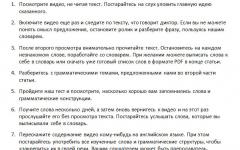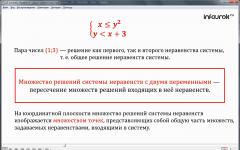Equation M(x, y) dx+ N(x, y) dy=0 is called generalized homogeneous if it is possible to select such a number k, that the left side of this equation becomes a homogeneous function of some degree m relatively x, y, dx And dy provided that x is considered the value of the first dimension, y – k‑ th measurements , dx And dy – respectively zero and (k-1) th measurements. For example, this would be the equation. (6.1)
Valid under the assumptions made regarding measurements
x,
y,
dx
And dy
members of the left side  And dy
will have dimensions -2, 2 respectively k And
k-1. Equating them, we obtain a condition that the required number must satisfy k:
-2 = 2k
=
k-1. This condition is satisfied when k
= -1 (with this k all terms on the left side of the equation under consideration will have a dimension of -2). Consequently, equation (6.1) is generalized homogeneous.
And dy
will have dimensions -2, 2 respectively k And
k-1. Equating them, we obtain a condition that the required number must satisfy k:
-2 = 2k
=
k-1. This condition is satisfied when k
= -1 (with this k all terms on the left side of the equation under consideration will have a dimension of -2). Consequently, equation (6.1) is generalized homogeneous.
A generalized homogeneous equation is reduced to an equation with separable variables using substitution  , Where z– new unknown function. Let us integrate equation (6.1) using the indicated method. Because k
= -1, then
, Where z– new unknown function. Let us integrate equation (6.1) using the indicated method. Because k
= -1, then  , after which we get the equation.
, after which we get the equation.
Integrating it, we find  , where
, where  . This is a general solution to equation (6.1).
. This is a general solution to equation (6.1).
§ 7. Linear differential equations of the 1st order.
A 1st order linear equation is an equation that is linear with respect to the desired function and its derivative. It looks like:
 ,
(7.1)
,
(7.1)
Where P(x)
And
Q(x)
– given continuous functions of x.
If the function
 ,
then equation (7.1) has the form:
,
then equation (7.1) has the form:  (7.2)
(7.2)
and is called a linear homogeneous equation, otherwise  it is called a linear inhomogeneous equation.
it is called a linear inhomogeneous equation.
The linear homogeneous differential equation (7.2) is an equation with separable variables:

 (7.3)
(7.3)
Expression (7.3) is the general solution of equation (7.2). To find a general solution to equation (7.1), in which the function P(x) denotes the same function as in equation (7.2), we apply a technique called the method of variation of an arbitrary constant and consists of the following: we will try to select the function C=C(x) so that the general solution to the linear homogeneous equation (7.2) would be a solution to the inhomogeneous linear equation (7.1). Then for the derivative of function (7.3) we obtain:
 .
.
Substituting the found derivative into equation (7.1), we will have:
or  .
.
Where  , Where
, Where  - arbitrary constant. As a result, the general solution to the inhomogeneous linear equation (7.1) will be (7.4)
- arbitrary constant. As a result, the general solution to the inhomogeneous linear equation (7.1) will be (7.4) 
The first term in this formula represents the general solution (7.3) of the linear homogeneous differential equation (7.2), and the second term of formula (7.4) is a particular solution of the linear inhomogeneous equation (7.1), obtained from the general (7.4) with  . We highlight this important conclusion in the form of a theorem.
. We highlight this important conclusion in the form of a theorem.
Theorem. If one particular solution of a linear inhomogeneous differential equation is known  , then all other solutions have the form
, then all other solutions have the form  , Where
, Where  - general solution of the corresponding linear homogeneous differential equation.
- general solution of the corresponding linear homogeneous differential equation.
However, it should be noted that to solve the linear inhomogeneous differential equation of the 1st order (7.1), another method is more often used, sometimes called the Bernoulli method. We will look for a solution to equation (7.1) in the form  . Then
. Then  . Let's substitute the found derivative into the original equation:
. Let's substitute the found derivative into the original equation:  .
.
Let us combine, for example, the second and third terms of the last expression and extract the function u(x)
behind the bracket:  (7.5)
(7.5)
We require the parenthesis to be nullified:  .
.
Let us solve this equation by setting an arbitrary constant C
equal to zero:  . With the found function v(x)
Let's return to equation (7.5):
. With the found function v(x)
Let's return to equation (7.5):  .
.
Solving it, we get:  .
.
Consequently, the general solution to equation (7.1) has the form.
def 1 DU type
called homogeneous differential equation of the first order(ODU).
Th 1 Let the following conditions be met for the function:
1) continuous at
Then ODE (1) has a general integral, which is given by the formula:
where is some antiderivative of the function With is an arbitrary constant.
Note 1 If for some the condition is met, then in the process of solving ODE (1) solutions of the form may be lost; such cases must be treated more carefully and each of them must be checked separately.
Thus from the theorem Th1 should general algorithm for solving ODE (1):
1) Make a replacement:
2) Thus, a differential equation with separable variables will be obtained, which should be integrated;
3) Return to old gvariables;
4) Check the values for their involvement in the solution original remote control, under which the condition will be satisfied
5) Write down the answer.
Example 1 Solve DE (4).
Solution: DE (4) is a homogeneous differential equation, since it has the form (1). Let's make a change (3), this will bring equation (4) to the form:
Equation (5) is the general integral of DE (4).
Note that when separating variables and dividing by, solutions could be lost, but this is not a solution to DE (4), which is easily verified by direct substitution into equality (4), since this value is not included in the domain of definition of the original DE.
Answer:
Note 2 Sometimes you can write ODEs in terms of differentials of variables X And u. It is recommended to move from this notation of the remote control to the expression through the derivative and only then perform the replacement (3).
Differential equations reduced to homogeneous ones.
def 2 The function is called homogeneous function of degree k in the area, for which the equality will be satisfied:
Here are the most common types of differential equations that can be reduced to form (1) after various transformations.
1) where is the function is homogeneous, degree zero, that is, the equality is valid: DE (6) is easily reduced to the form (1), if we put , which is further integrated using replacement (3).
2) (7), where the functions are homogeneous of the same degree k . DE of the form (7) is also integrated using substitution (3).
Example 2 Solve DE (8).
Solution: Let us show that DE (8) is homogeneous. Let us divide by what is possible, since it is not a solution to DE (8).
Let's make a change (3), this will bring equation (9) to the form:
Equation (10) is the general integral of DE (8).
Note that when separating variables and dividing by, solutions corresponding to the values of and could be lost. Let's check these expressions. Let's substitute them into DE (8):
Answer:
It is interesting to note that when solving this example, a function appears called the “sign” of the number X(reads " signum x"), defined by the expression:
Note 3 Reducing the DE (6) or (7) to the form (1) is not necessary; if it is obvious that the DE is homogeneous, then you can immediately make the replacement
3) A DE of the form (11) is integrated as an ODE if , and the substitution is initially performed:
(12), where is the solution of the system: (13), and then use replacement (3) for the function. After receiving the general integral, they return to the variables X And at.
If , then, assuming in equation (11), we obtain a differential equation with separable variables.
Example 3 Solve the Cauchy problem (14).
Solution: Let us show that DE (14) is reduced to a homogeneous DE and integrated according to the above scheme:
Let us solve the inhomogeneous system of linear algebraic equations (15) using the Cramer method:
Let's make a change of variables and integrate the resulting equation:
(16) – General integral of DE (14). When separating variables, solutions could be lost when dividing by an expression, which could be obtained explicitly after solving the quadratic equation. However, they are taken into account in the general integral (16) at
Let's find a solution to the Cauchy problem: substitute the values and into the general integral (16) and find With.
Thus, the partial integral will be given by the formula:
Answer:
4) It is possible to reduce some DEs to homogeneous ones for a new, as yet unknown function if we apply a substitution of the form:
In this case the number m is selected from the condition that the resulting equation, if possible, becomes homogeneous to some degree. However, if this cannot be done, then the DE in question cannot be reduced to a homogeneous one in this way.
Example 4 Solve DE. (18)
Solution: Let us show that DE (18) is reduced to a homogeneous DE using substitution (17) and is further integrated using substitution (3):
Let's find With:
Thus, a particular solution of DE (24) has the form
.
Differential equations.
§ 1. Basic concepts about ordinary differential equations.
Definition 1. Ordinary differential equation n– th order for the function y argument x is called a relation of the form
Where F– a given function of its arguments. In the name of this class of mathematical equations, the term “differential” emphasizes that they include derivatives  (functions formed as a result of differentiation); the term “ordinary” indicates that the desired function depends on only one real argument.
(functions formed as a result of differentiation); the term “ordinary” indicates that the desired function depends on only one real argument.
An ordinary differential equation may not contain an explicit argument x,
the required function  and any of its derivatives, but the highest derivative
and any of its derivatives, but the highest derivative  must be included in the equation n-
th order. For example
must be included in the equation n-
th order. For example
A)  – first order equation;
– first order equation;
b)  – third order equation.
– third order equation.
When writing ordinary differential equations, the notation for derivatives in terms of differentials is often used:
V)  – second order equation;
– second order equation;
G)  – first order equation,
– first order equation,
generator after division by dx equivalent form of specifying the equation:  .
.
Function  is called a solution to an ordinary differential equation if, upon substitution into it, it turns into an identity.
is called a solution to an ordinary differential equation if, upon substitution into it, it turns into an identity.
For example, a 3rd order equation
Has a solution  .
.
Finding by one method or another, for example, selection, one function that satisfies the equation does not mean solving it. To solve an ordinary differential equation means to find All functions that form an identity when substituted into an equation. For equation (1.1), a family of such functions is formed using arbitrary constants and is called the general solution of an ordinary differential equation n-th order, and the number of constants coincides with the order of the equation: The general solution may be, but is not explicitly resolved with respect to y(x) : In this case, the solution is usually called the general integral of equation (1.1).
For example, the general solution of the differential equation  is the following expression: , and the second term can also be written as
is the following expression: , and the second term can also be written as  , since an arbitrary constant
, since an arbitrary constant  , divided by 2, can be replaced by a new arbitrary constant
, divided by 2, can be replaced by a new arbitrary constant  .
.
By assigning some admissible values to all arbitrary constants in the general solution or in the general integral, we obtain a certain function that no longer contains arbitrary constants. This function is called a partial solution or partial integral of equation (1.1). To find the values of arbitrary constants, and therefore a particular solution, various additional conditions to equation (1.1) are used. For example, the so-called initial conditions can be specified at (1.2)
On the right-hand sides of the initial conditions (1.2) the numerical values of the function and derivatives are specified, and the total number of initial conditions is equal to the number of defined arbitrary constants.
The problem of finding a particular solution to equation (1.1) based on the initial conditions is called the Cauchy problem.
§ 2. Ordinary differential equations of the 1st order - basic concepts.
Ordinary differential equation of the 1st order ( n=1) has the form:  or, if it can be resolved with respect to the derivative:
or, if it can be resolved with respect to the derivative:  . General solution y=
y(x,WITH) or general integral
. General solution y=
y(x,WITH) or general integral  1st order equations contain one arbitrary constant. The only initial condition for a 1st order equation
1st order equations contain one arbitrary constant. The only initial condition for a 1st order equation  allows you to determine the value of a constant from a general solution or from a general integral. Thus, a particular solution will be found or, which is the same, the Cauchy problem will be solved. The question of the existence and uniqueness of a solution to the Cauchy problem is one of the central ones in the general theory of ordinary differential equations. For a 1st order equation, in particular, the theorem is valid, which is accepted here without proof.
allows you to determine the value of a constant from a general solution or from a general integral. Thus, a particular solution will be found or, which is the same, the Cauchy problem will be solved. The question of the existence and uniqueness of a solution to the Cauchy problem is one of the central ones in the general theory of ordinary differential equations. For a 1st order equation, in particular, the theorem is valid, which is accepted here without proof.
Theorem 2.1. If in the equation the function  and its partial derivative
and its partial derivative  continuous in some region D plane XOY, and in this area a point is specified
continuous in some region D plane XOY, and in this area a point is specified  , then there is a unique solution that satisfies both the equation and the initial condition
, then there is a unique solution that satisfies both the equation and the initial condition  .
.
Geometrically, the general solution of a 1st order equation is a family of curves on the plane XOY, having no common points and differing from each other in one parameter - the value of the constant C. These curves are called integral curves for a given equation. Integral equation curves have an obvious geometric property: at each point, the tangent of the tangent to the curve is equal to the value of the right side of the equation at this point:  . In other words, the equation is given in the plane XOY field of directions of tangents to integral curves. Comment: It should be noted that to Eq.
. In other words, the equation is given in the plane XOY field of directions of tangents to integral curves. Comment: It should be noted that to Eq.  the equation and the so-called equation are given in symmetric form
the equation and the so-called equation are given in symmetric form  .
.
§ 3. Differential equations of the 1st order with separable variables.
Definition. A differential equation with separable variables is an equation of the form  (3.1)
(3.1)
or an equation of the form (3.2)
In order to separate the variables in equation (3.1), i.e. reduce this equation to the so-called separated variable equation, do the following:
 ;
;
Now we need to solve the equation g(y)= 0 . If it has a real solution y= a, That y= a will also be a solution to equation (3.1).
Equation (3.2) is reduced to a separated variable equation by dividing by the product  :
:
 , which allows us to obtain the general integral of equation (3.2):
, which allows us to obtain the general integral of equation (3.2):  . (3.3)
. (3.3)
Integral curves (3.3) will be supplemented with solutions  , if such solutions exist.
, if such solutions exist.
Solve the equation: .
We separate the variables:

 .
.
Integrating, we get 
Further from the equations  And
And  we find x=1,
y=-1.
These solutions are private solutions.
we find x=1,
y=-1.
These solutions are private solutions.
§ 4. Homogeneous differential equations of the 1st order.
Definition 1. A 1st order equation is called homogeneous if for its right side for any  the ratio is valid
the ratio is valid  , called the condition of homogeneity of a function of two variables of zero dimension.
, called the condition of homogeneity of a function of two variables of zero dimension.
Example 1. Show that function  - homogeneous zero dimension.
- homogeneous zero dimension.
Solution.
 ,
,
Q.E.D.
Theorem. Any function  - homogeneous and, conversely, any homogeneous function
- homogeneous and, conversely, any homogeneous function  zero dimension is reduced to the form
zero dimension is reduced to the form  .
.
Proof.
The first statement of the theorem is obvious, because  . Let's prove the second statement. Let's put
. Let's prove the second statement. Let's put  , then for a homogeneous function
, then for a homogeneous function  , which was what needed to be proven.
, which was what needed to be proven.
Definition 2. Equation (4.1)
in which M And N– homogeneous functions of the same degree, i.e. have the property for all  , is called homogeneous.
, is called homogeneous.
Obviously, this equation can always be reduced to the form  (4.2), although to solve it you don’t have to do this.
(4.2), although to solve it you don’t have to do this.
A homogeneous equation is reduced to an equation with separable variables by replacing the desired function y according to the formula y=
zx,
Where z(x)
– new required function. Having performed this substitution in equation (4.2), we obtain:  or
or  or
or  .
.
Integrating, we obtain the general integral of the equation with respect to the function z(x)
 , which after repeated replacement
, which after repeated replacement  gives the general integral of the original equation. Moreover, if
gives the general integral of the original equation. Moreover, if  - roots of the equation
- roots of the equation  , then the functions
, then the functions  - solving a homogeneous given equation. If
- solving a homogeneous given equation. If  , then equation (4.2) takes the form
, then equation (4.2) takes the form
 and becomes an equation with separable variables. Its solutions are semi-direct:
and becomes an equation with separable variables. Its solutions are semi-direct:  .
.
Comment. Sometimes it is advisable to use the substitution instead of the above substitution x= zy.
§ 5. Differential equations reduced to homogeneous ones.
Consider an equation of the form  . (5.1)
. (5.1)
If  , then this is the equation using substitution, where
, then this is the equation using substitution, where  And
And  - new variables, and
- new variables, and  - some constant numbers determined from the system
- some constant numbers determined from the system 
Reduced to a homogeneous equation 
If  , then equation (5.1) takes the form
, then equation (5.1) takes the form
 .
.
Believing z= ax+ by, we arrive at an equation that does not contain an independent variable.
Let's look at examples.
Example 1.
Integrate Equation
and highlight the integral curve passing through the points: a) (2;2); b) (1;-1).
Solution.
Let's put y= zx. Then dy= xdz+ zdx And
Let's shorten it by  and gather members at dx And dz:
and gather members at dx And dz:
Let's separate the variables: 
 .
.
Integrating, we get ;
or  ,
,  .
.
Replacing here z on  , we obtain the general integral of the given equation in the form (5.2)
, we obtain the general integral of the given equation in the form (5.2)  or
or 
 .
.
This is a family of circles  , whose centers lie on the straight line y =
x and which at the origin are tangent to the line y +
x = 0.
This liney
= -
x
in turn, a particular solution to the equation.
, whose centers lie on the straight line y =
x and which at the origin are tangent to the line y +
x = 0.
This liney
= -
x
in turn, a particular solution to the equation.
Now the mode of the Cauchy problem:
A) putting in the general integral x=2,
y=2,
we find C=2, therefore the required solution will be  .
.
B) none of the circles (5.2) passes through the point (1;-1). But it's semi-straight y = -
x,  passes through the point and gives the desired solution.
passes through the point and gives the desired solution.
Example 2. Solve the equation: .
Solution.
The equation is a special case of equation (5.1).
Determinant  in this example
in this example  , so we need to solve the following system
, so we need to solve the following system 
Solving, we get that  . By performing a substitution in a given equation
. By performing a substitution in a given equation  , we obtain a homogeneous equation. Integrating it using substitution
, we obtain a homogeneous equation. Integrating it using substitution  , we find
, we find  .
.
Returning to old variables x And y according to formulas  , we have .
, we have .
§ 6. Generalized homogeneous equation.
Equation M(x,
y)
dx+
N(x,
y)
dy=0
is called generalized homogeneous if it is possible to select such a number k, that the left side of this equation becomes a homogeneous function of some degree m relatively x,
y,
dx And dy provided that x is considered the value of the first dimension, y – k th measurements ,
dx And dy –
respectively zero and (k-1)
th measurements. For example, this would be the equation  . (6.1)
. (6.1)
Valid under the assumptions made regarding measurements
x,
y,
dx And dy members of the left side  And dy will have dimensions -2, 2 respectively k And k-1. Equating them, we obtain a condition that the required number must satisfy k: -2 = 2k=k-1. This condition is satisfied when k= -1 (with this k all terms on the left side of the equation under consideration will have a dimension of -2). Consequently, equation (6.1) is generalized homogeneous.
And dy will have dimensions -2, 2 respectively k And k-1. Equating them, we obtain a condition that the required number must satisfy k: -2 = 2k=k-1. This condition is satisfied when k= -1 (with this k all terms on the left side of the equation under consideration will have a dimension of -2). Consequently, equation (6.1) is generalized homogeneous.
A generalized homogeneous equation is reduced to an equation with separable variables using substitution  , Where z– new unknown function. Let us integrate equation (6.1) using the indicated method. Because k= -1, then
, Where z– new unknown function. Let us integrate equation (6.1) using the indicated method. Because k= -1, then  , after which we get the equation .
, after which we get the equation .
Integrating it, we find  , where
, where  . This is a general solution to equation (6.1).
. This is a general solution to equation (6.1).
§ 7. Linear differential equations of the 1st order.
A 1st order linear equation is an equation that is linear with respect to the desired function and its derivative. It looks like:
 , (7.1)
, (7.1)
Where P(x)
And Q(x)
– given continuous functions of x.
If the function  ,
then equation (7.1) has the form:
,
then equation (7.1) has the form:  (7.2)
(7.2)
and is called a linear homogeneous equation, otherwise  it is called a linear inhomogeneous equation.
it is called a linear inhomogeneous equation.
The linear homogeneous differential equation (7.2) is an equation with separable variables:

 (7.3)
(7.3)
Expression (7.3) is the general solution of equation (7.2). To find a general solution to equation (7.1), in which the function P(x) denotes the same function as in equation (7.2), we apply a technique called the method of variation of an arbitrary constant and consists of the following: we will try to select the function C=C(x) so that the general solution to the linear homogeneous equation (7.2) would be a solution to the inhomogeneous linear equation (7.1). Then for the derivative of function (7.3) we obtain:
 .
.
Substituting the found derivative into equation (7.1), we will have:
or  .
.
Where  , where is an arbitrary constant. As a result, the general solution to the inhomogeneous linear equation (7.1) will be (7.4)
, where is an arbitrary constant. As a result, the general solution to the inhomogeneous linear equation (7.1) will be (7.4) 
The first term in this formula represents the general solution (7.3) of the linear homogeneous differential equation (7.2), and the second term of formula (7.4) is a particular solution of the linear inhomogeneous equation (7.1), obtained from the general (7.4) with  . We highlight this important conclusion in the form of a theorem.
. We highlight this important conclusion in the form of a theorem.
Theorem. If one particular solution of a linear inhomogeneous differential equation is known  , then all other solutions have the form
, then all other solutions have the form  , Where
, Where  - general solution of the corresponding linear homogeneous differential equation.
- general solution of the corresponding linear homogeneous differential equation.
However, it should be noted that to solve the linear inhomogeneous differential equation of the 1st order (7.1), another method is more often used, sometimes called the Bernoulli method. We will look for a solution to equation (7.1) in the form  . Then
. Then  . Let's substitute the found derivative into the original equation:
. Let's substitute the found derivative into the original equation:  .
.
Let us combine, for example, the second and third terms of the last expression and extract the function u(x)
behind the bracket:  (7.5)
(7.5)
We require the parenthesis to be nullified:  .
.
Let us solve this equation by setting an arbitrary constant C equal to zero:  . With the found function v(x)
Let's return to equation (7.5):
. With the found function v(x)
Let's return to equation (7.5):  .
.
Solving it, we get:  .
.
Therefore, the general solution to equation (7.1) has the form:
§ 8. Bernoulli's equation.
Definition.
Differential equation of the form  , Where
, Where  , is called Bernoulli's equation.
, is called Bernoulli's equation.
Assuming that  , divide both sides of the Bernoulli equation by
, divide both sides of the Bernoulli equation by  . As a result we get:
. As a result we get:  (8.1)
(8.1)
Let's introduce a new function  . Then
. Then  . Let us multiply equation (8.1) by
. Let us multiply equation (8.1) by  and let's go to the function z(x)
:
and let's go to the function z(x)
:  , i.e. for function z(x)
obtained a linear inhomogeneous equation of the 1st order. This equation is solved using the methods discussed in the previous paragraph. Let us substitute into its general solution instead z(x)
expression
, i.e. for function z(x)
obtained a linear inhomogeneous equation of the 1st order. This equation is solved using the methods discussed in the previous paragraph. Let us substitute into its general solution instead z(x)
expression  , we obtain the general integral of the Bernoulli equation, which is easily resolved with respect to y. At
, we obtain the general integral of the Bernoulli equation, which is easily resolved with respect to y. At  solution is added y(x)=0
. Bernoulli's equation can also be solved without making the transition to a linear equation by substitution
solution is added y(x)=0
. Bernoulli's equation can also be solved without making the transition to a linear equation by substitution  , and using the Bernoulli method, discussed in detail in § 7. Let's consider the use of this method to solve the Bernoulli equation using a specific example.
, and using the Bernoulli method, discussed in detail in § 7. Let's consider the use of this method to solve the Bernoulli equation using a specific example.
Example. Find the general solution to the equation:  (8.2)
(8.2)
Solution.
Therefore, the general solution to this equation has the form:  , y(x)=0.
, y(x)=0.
§ 9. Differential equations in total differentials.
Definition. If in Eq. M(x, y) dx+ N(x, y) dy=0 (9.1) the left side is the total differential of some function U(x, y) , then it is called a total differential equation. This equation can be rewritten as du(x, y)=0 , therefore, its general integral is u(x, y)= c.
For example, the equation xdy+
ydx=0
there is an equation in total differentials, since it can be rewritten in the form d(xy)=0.
The general integral will be xy=
c- arbitrary differentiable function. Let us differentiate (9.3) with respect to u
§ 10. Integrating factor.
If the equation M(x, y) dx + N(x, y) dy = 0 is not a total differential equation and there is a function µ = µ(x, y) , such that after multiplying both sides of the equation by it, we get the equation
µ(Mdx + Ndy) = 0 in total differentials, i.e. µ(Mdx + Ndy)du, then the function µ(x, y) is called the integrating factor of the equation. In the case where the equation is already an equation in total differentials, we assume µ = 1.
If the integrating factor is found µ , then the integration of this equation is reduced to multiplying both its sides by µ and finding the general integral of the resulting equation in total differentials.
If µ
is a continuously differentiable function of x And y, That  .
.
It follows that the integrating factor µ satisfies the following 1st order partial differential equation:
 (10.1).
(10.1).
If it is known in advance that µ= µ(ω) , Where ω – given function from x And y, then equation (10.1) reduces to an ordinary (and, moreover, linear) equation with an unknown function µ on independent variable ω :
 (10.2),
(10.2),
Where  , i.e. the fraction is a function only of ω
.
, i.e. the fraction is a function only of ω
.
Solving equation (10.2), we find the integrating factor
 , With = 1.
, With = 1.
In particular, the equation M(x, y) dx + N(x, y) dy = 0 has an integrating factor that depends only on x(ω = x) or only from y(ω = y), if the following conditions are met accordingly:
 ,
, 
 ,
,  .
.
By clicking on the "Download archive" button, you will download the file you need completely free of charge.
Before downloading this file, think about those good abstracts, tests, term papers, dissertations, articles and other documents that are lying unclaimed on your computer. This is your work, it should participate in the development of society and benefit people. Find these works and submit them to the knowledge base.
We and all students, graduate students, young scientists who use the knowledge base in their studies and work will be very grateful to you.
To download an archive with a document, enter a five-digit number in the field below and click the "Download archive" button
Similar documents
Cauchy problems for differential equations. Graph of the solution to a first order differential equation. Equations with separable variables and reducing to a homogeneous equation. Homogeneous and inhomogeneous linear equations of the first order. Bernoulli's equation.
lecture, added 08/18/2012
Basic concepts of the theory of ordinary differential equations. Sign of an equation in total differentials, construction of a general integral. The simplest cases of finding the integrating factor. The case of a multiplier that depends only on X and only on Y.
course work, added 12/24/2014
Features of differential equations as relationships between functions and their derivatives. Proof of the theorem of existence and uniqueness of the solution. Examples and algorithm for solving equations in total differentials. Integrating factor in examples.
course work, added 02/11/2014
Riccati differential equations. General solution of a linear equation. Finding all possible solutions to Bernoulli's differential equation. Solving equations with separable variables. General and special solutions of the Clairaut differential equation.
course work, added 01/26/2015
Equation with separable variables. Homogeneous and linear differential equations. Geometric properties of integral curves. Complete differential of a function of two variables. Determination of the integral by Bernoulli methods and variations of an arbitrary constant.
abstract, added 08/24/2015
Concepts and solutions of the simplest differential equations and differential equations of arbitrary order, including those with constant analytical coefficients. Systems of linear equations. Asymptotic behavior of solutions of some linear systems.
thesis, added 06/10/2010
General integral of an equation, application of the Lagrange method for solving an inhomogeneous linear equation with an unknown function. Solving a differential equation in parametric form. Euler's condition, first order equation in total differentials.
test, added 11/02/2011








